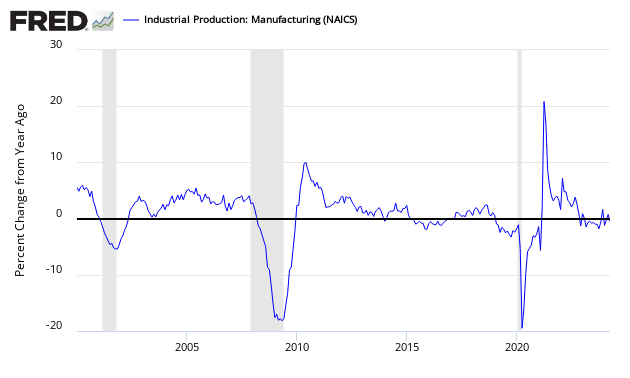January 2019 Texas Manufacturing Survey Improves
Of the five Federal Reserve districts which have released their January manufacturing surveys - most were in expansion but their growth rates were generally slowing. A complete summary follows.

Analyst Opinion of Dallas Fed Manufacturing Survey
This survey remains in positive territory with new orders declining and unfilled orders improving (and now in expansion). This report should be considered little changed from last month (and not an improvement as the headlines suggest).
The expectations from Econoday was -7.0 to 7.0 (consensus -4.6), and the reported value was 14.5. From the Dallas Fed:
Texas factory activity continued to expand in January, according to business executives responding to the Texas Manufacturing Outlook Survey. The production index, a key measure of state manufacturing conditions, rose from 7.3 to 14.5, indicating an acceleration in output growth.
Other measures of manufacturing activity also suggested continued expansion in January, although the pace of demand growth slowed a bit. The capacity utilization index rose seven points to 14.8, and the shipments index rose five points to 11.4. Meanwhile, the new orders index edged down to 11.6 and the growth rate of new orders index fell from 5.8 to 1.2.
Perceptions of broader business conditions improved in January. The general business activity index rebounded from a multiyear low of -5.1 in December to 1.0 in January. This near-zero reading suggests manufacturers were fairly balanced in their assessment of whether activity had improved or worsened from last month. The company outlook index also rebounded from negative territory this month, rising more than 10 points to 7.1.
Labor market measures suggested slower growth in employment and workweek length in January. The employment index retreated four points to 6.6, a two-year low. Sixteen percent of firms noted net hiring, compared with 10 percent noting net layoffs. The hours worked index edged down to 3.6.
Upward pressure on input prices and wages eased further in January, while pressure on selling prices held steady. The raw materials price index slipped eight points to 21.2, and the wages and benefits index ticked down two points to 27.4. Meanwhile, the finished goods price index held steady at 6.4.
Expectations regarding future business conditions pushed further positive in January. The indexes of future general business activity and future company outlook rose to 11.7 and 22.3, respectively. Other indexes of future manufacturing activity also posted increases this month.
Dallas Fed (hyperlink to reports):
(Click on image to enlarge)
Source: Dallas Fed
Summary of all Federal Reserve Districts Manufacturing:
Richmond Fed (hyperlink to reports):
(Click on image to enlarge)
Kansas Fed (hyperlink to reports):
(Click on image to enlarge)
Philly Fed (hyperlink to reports):
(Click on image to enlarge)
New York Fed (hyperlink to reports):
(Click on image to enlarge)
Federal Reserve Industrial Production - Actual Data (hyperlink to report):
(Click on image to enlarge)

Holding this and other survey's Econintersect follows accountable for their predictions, the following graph compares the hard data from Industrial Products manufacturing subindex (dark blue bar) and US Census manufacturing shipments (lighter blue bar) to the Dallas Fed survey (light blue bar).
Comparing Surveys to Hard Data:
(Click on image to enlarge)

In the above graphic, hard data is the long bars, and surveys are the short bars. The arrows on the left side are the key to growth or contraction.
Disclaimer: No content is to be construed as investment advise and all content is provided for informational purposes only.The reader is solely responsible for determining whether any investment, ...
more







